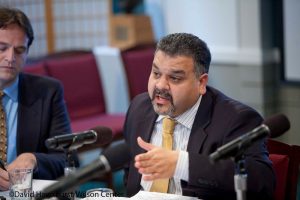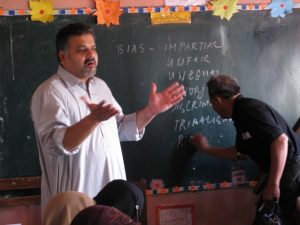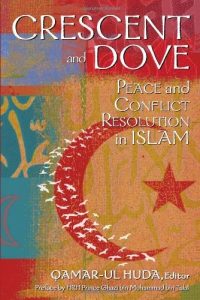
In the fifth segment of NESA South Asia Interview Series, Professor Hassan Abbas interviews Professor Qamar-ul Huda who is a non-resident fellow at The Atlantic Council in Washington, D.C and an adjunct associate professor at Georgetown University. He formerly worked as a senior policy advisor to the U.S. State Department Secretary’s Office on Religion and Global Affairs where he focused on policies related to the roles of civil society, religious leaders, and multilateral organizations in preventing violent extremism. He also served as a director at Hedayah: The International Centre of Excellence for Countering Violent Extremism based in Abu Dhabi, U.A.E. Dr. Huda also led the CVE Program at the U.S. Institute for Peace (USIP) Academy for Conflict Analysis and Transformation and was a founding member of Center for Global Policy’s Conflict, Stabilization, and Development Program. (Thanks are also due to NESA Professor Anne Moisan for contributing with questions for Dr. Huda)
HASSAN ABBAS: Congratulations on your recent publication “A Critique of Countering Violent Extremism Programs in Pakistan” (Center for Global Policy, July 2020). What are the core findings from the report that are crucial for CVE practitioners today? What are your top 3-5 findings?
QAMAR-UL HUDA: I think the top five findings from the policy report are the following:
- In Pakistan – a frontline state in the war of terrorism- Countering Violent Extremism (CVE) policies and programs are still fundamentally controversial, misunderstood, and strongly criticized by local human rights groups and religious leaders. Pakistan state institutions and civil society organizations have implemented a variety of CVE programs but there have been no measures of the programs’ effectiveness or impact analysis, and this raises concerns about the fundamental nature of CVE programs.
- One area I discovered in researching for the report was that Pakistani NGOs and civil society stakeholders raised serious concerns regarding CVE thinking and assumptions on radicalization and extremism because they felt these ideas were imported by the global community of researchers. These assumptions were never debated internally by Pakistan’s academic research community. The notion of radicalism was not contested but there were repeated opinions on whether there could be a more nuanced local cultural understanding. That is to say Pakistani NGO organizations and CVE workshop participants repeatedly expressed having grievances against inept, oppressed governments or government policies or international actors which did not explicitly make them radicals. Also, there were tremendous amount of push-back on the fact that Pakistani CVE programs over-emphasized religious figures or religious organizations, and this approach’s primary focus on religion lacked a comprehensive scheme.
- CVE Programs were designed and implemented with a heavy emphasis on counter-messaging to the propaganda of the violent extremists. Strategic communications to interfere, manipulate, and disrupt the extremists’ propaganda meant supporting religious leaders to counter new narratives but there was never a strategic plan in place to monitor or evaluate the effectiveness of the counter-messaging or an understanding of its impact. This report discovered project evaluations but there was no single database or single institute supervising the monitoring or evaluations of CVE counter-messaging to inform better practices.
- As “CVE” became more mistrusted and tainted in Pakistan, NGOs and civil society groups were put at risk for taking part in these activities and receiving international aid. NGOs implementing CVE programs – whether sponsored by Pakistan government or by international donors – risk falling under suspicion of contributing to ethnic, religious and sectarian conflicts. CVE funds received by NGOs were questioned by intelligence on how they were able to access CVE funds and how much of the funds were actually used for CVE activities. The suspicion undermined the credibility of NGOs who were attempting to bring grassroots leaders to learn about CVE counter-messaging.
- Within the global CVE research community there is a consensus, for over eight years, that any successful CVE policy will be based upon multidisciplinary approaches and multi-agency cooperation. Attempts to combat the totalitarian nature of violent extremist groups require a holistic understanding of local sectarian grievances and structural issues such as energy, access to water, housing, quality of education, healthcare services. But, in Pakistan’s CVE policy and/ or programming, the report did not see multiagency cooperation or international funded program coordination. However, Pakistan has a unique opportunity to correct its course by building and developing upon its original national strategy.
HASSAN ABBAS: The report appears to be cautioning CVE experts not to play with religious narratives and argues that engaging religious scholars to challenge and condemn violent extremism may not in reality be an effective or appropriate CVE practice. Kindly elaborate this point further as most Muslim states are heavily engaged in this exercise.
QAMAR-UL HUDA: Even before the White House Summit on CVE in February, 2014, the global CVE research and policy community were intent on finding and funding “moderate Muslim religious networks” (Rand Report), “supporting non-violent jihadi Salafi groups” (Graeme Wood), “to collaborate with global Salafism (William McCants and Shadi Hamid), and leverage the rising middle class Shi’ites in the Middle East against the Hezbollah movement and the ‘Ulama of Iran (Vali Nasr).
The role of religion in countering violent extremism — especially during the peak of Daesh’s rise after the capture of Mosul, Iraq, in 2014 — was tied to an abstract computation of funding a religious leader’s organization, building trusted networks, and supporting the dissemination of CVE messaging about peace and pluralism. Considering religious engagement as an aspect of security was problematic to some, but others argued that the stakes were too high to ignore the role of religious actors in CVE activities.

Historically, religion has been at the center of politics and the public sphere in Muslim-majority countries, and their specific roles have evolved differently than in western countries. Nevertheless, western countries have constitutional and legal restraints in cooperating, collaborating, and funding religion so this complicates CVE funding policies.
The key issue is not to ignore religion, nor center religion as the primary outlet of CVE activities. Western governments tend not to have religion experts who can advise policy makers on the direct impact of religious collaboration.
Muslim-majority countries will continue to emphasize and accentuate mainstream rational religious leaders as an antidote, but I think it is combined with youth, gender, media, and other educational programs.
HASSAN ABBAS: You have been working on peace building and CVE issues as an academic and practitioner for many years and your work with Hedayah, USIP and State department during the Obama administration is well recognized. It appears that the US policy interest in this approach has diminished over time. Why is that the case and what are your recommendations?
QAMAR-UL HUDA: Yes, thank you. In the previous administration there was a strong emphasis on working with both government and NGO’s to align resources and human capital toward building peaceful relationships. I think there is a generation of political scientists, policymakers, and researchers influenced by Harvard University’s Joseph Nye’s “Soft Power: The Means to Success in World Politics.” Whether explicitly stated or not, many of American foundations, philanthropies, think-tanks, and research centers have invested in people-to-people dialogues, cultural and intellectual programs for soft power relationships.
With the current administration’s “America First” foreign policy, it sends a message that national interests outweigh multilateralism. In a time when American leadership is desperately needed in Syria, Libya, Lebanon, Yemen, Iraq, Hong Kong, to name a few, America is retreating from its historical leadership at the World Health Organization (WHO), United Nations, NATO, and other prominent commitments.
I think the American public is still supportive of an engaged American foreign policy; one that promotes values, principles, mutual respect, and builds upon mutual interests. Peacebuilding and conflict transformation is interconnected to the universal declaration of human rights but also tied to a high-priority of promoting the right to protect and defend the marginalized, such as refugees, and to defend free speech, freedom to assemble, and to live in free societies.
ANNE MOISAN: In hindsight, how has the US’s WOT backfired and opened a Pandora’s box where countries to include Pakistan immediately followed suit, embraced CT, and proceeded to track and prosecute anyone the govt labeled as “terrorist”. Is there any way of reversing the indiscriminate application? What checks and balances exist?
QAMAR-UL HUDA: The War on Terror was an ambitious multilateral CT policy that attempted to share intelligence, military exercises, and CT approaches to mitigate the rise of terrorism. Conceived during the height of the Iraq war, and ongoing war in Afghanistan, the original thinking was to limit the terrorists to a geographic location by reducing their ability to attack. However, against most the thinking of most strategists, there was not a calculation that inner schisms would create splinter groups who would be more organized and sophisticated than their predecessors, i.e., ISIS.
Then there were violent extremist groups in Sahel, Africa and in Philippines and South Asia, who gave their allegiances to ISIS in return for resources, training, and access to greater networks. Yes, it was a pandora box that backfired.
Pakistan joined in the war against terrorism when the U.S. invaded Afghanistan in October 2001. But from 2001 to 2014, Pakistan was being attacked by homegrown and foreign terrorists. With a multiprong approach in Afghanistan, Pakistan’s CT policy evolved to concentrate on domestic affairs after the December 2014 Army Public School massacre of over one hundred and fifty children in Peshawar. The attack was claimed by Tehrik-i-Taliban Pakistan (TTP) and scores of many terrorist attacks were to be planned afterwards. Pakistan needed to: (1) Construct and enforce a CT policy to defuse TTP and al-Qaida and affiliates; and (2) Ensure the ideology of TTP and al-Qaida were not attractive to other possible recruiters.
Pakistan’s entry to the CT world was initially a commitment to the global war on terrorism, but the terrorists (and sympathizers) took hold in geographic areas of Pakistan. I do not think Pakistan was prepared to deal with the variety of violent extremists’ activities in KPK, Sindh, Punjab, and Baluchistan.
ANNE MOISAN: The report addresses the role of donors and the impacts of importing CVE programs. While the report criticizes donor driven programs vs those locally developed, can you address the specific “types” of programs that are chosen by recipient countries because they better lend themselves to “measurement” for donor demanded accountability, but in fact might entirely miss the mark on effectiveness.

QAMAR-UL HUDA: International organizations like Community World Service Asia and Norwegian Church Aid continue to implement peace-building projects through local partners as a pretext for CVE. Herein lies the problem: international donors are trying to bypass the stigma of CVE with peacebuilding and conflict management workshops to identify local actors who can be reliable CVE implementers and practitioners. This puts the NGOs at risk because local intelligence forces become involved.
On the issue of effectiveness, more broadly, this is an existing problem throughout the global CVE community. Aside from several reports from OECD, UNCTED, ICCT, and other institutions, we have yet to have a baseline for measuring CVE activities for effectiveness. Some have designed evaluations for ‘impact analysis’ but these reports were based on short-term analysis. Resources and political will are needed for a long-term commitment to CVE impact analysis, which includes donor accountability but goes beyond the project itself. This is why one of the recommendations of the report is for Pakistan to create a National CVE Task Force to assess the work done, and lay down the foundation for a long-term policy.
The report recommends an urgent policy corrective for Pakistani policymakers to vigorously review whether CVE policies and practices are fit for their purpose. CVE measures in Pakistan involve a complicated web of political, social, economic, tribal, legal, provincial, and religious issues, all of which need to be understood in their entirety. There needs to be an intensive review of CVE strategies, frameworks, and approaches especially in a country where Pakistani counterparts are experts trained in these areas and capable of ensuring a multitude of issues are factored into any preventative program.
HASSAN ABBAS: In your earlier work you focused on political Sufism, Sufi networks and historical Sufism. Can you elaborate if modern Sufism has a role, if any, in peacebuilding?
QAMAR-UL HUDA: Thank you for asking about my earlier academic work. As a trained political historian with a focus on intellectual discourses, I was fascinated how the Sufi tradition was a platform for a variety of Islamic practices and socio-cultural-exchanges. In the South Asian context, the prominent Sufi orders like the Suhrawardy, Naqshbandi, and Chishti orders included Jafari, Ismaili, Hanbali, Hanafi, Maliki, Zaydi schools of thought. The key textbooks of these orders credit practitioners from these schools and usually praised the need to incorporate their thinking to the order.
Modern Sufism has had its own complications of evolution where piety, rituals, and emotional spiritualism are more emphasized. But, within Sufism, there is an incredible amount of literature on peace -inner and outer-, reducing conflicts, adhering to the sacred, and remaining true to the spiritual path. However modern Sufism and Sufi orders have their share of not being able to transcend their own fiefdoms to learn, engage, and interact as their predecessors have done before. This is due to a host of institutionalization and political revivalism issues that have happened across the board in the Muslim world.
South Asian Sufis are a distinct group. They are keenly aware of language and rituals, but more importantly, Sufi leaders repeatedly speak about what distracts one form the spiritual life. Peacebuilding (aman-kari) or peace (aman) is not just a topic but they preach a detailed system of living surrounding it. Having worked with Sufis from Afghanistan, Pakistan, India, Bangladesh and Sri Lanka, I’ve learned about their diversity and desire to be inclusive with other faith traditions.
HASSAN ABBAS: Moving to a slightly different topic, I read your paper on “Russia’s Strategy Toward Islam and Muslims” and wonder if you can share the gist of your thoughts on the subject. What is driving President Putin’s aggressive posture in Middle East?
QAMAR-UL HUDA: Russia is interested in engaging with the Muslim World. It has been expending diplomatic energy to increase cooperation with the political office of the Taliban based in Doha, Qatar, to position itself as the great power capable of effectively mediating between the insurgent movement and Kabul. The Taliban’s goal of seeking broad international recognition as a legitimate Afghan national movement is what the Russians are trying to leverage to their advantage.
While the U.S. is conceding significant political space, it is not the only cause of Russia’s ascent as a definitive geopolitical player in key regions of the core of the Muslim world, i.e., North Africa, the Levant, the Arabian Peninsula, the northern rim from Turkey to Iran, and beyond to South Asia. Russia’s increasing prominence is a result of Putin’s efforts to geopolitically rehabilitate Moscow after the fall of the Soviet Union, especially and the Kremlin’s concern of its own Muslim population of 22 million.
Putin’s involvement with Muslim-majority countries is primarily due to: (1) the Muslim communities in Russia (particularly ongoing unrest within the North Caucasus region); (2) the predominant Muslim communities in the former Soviet republics in Central Asia; and (3) the desire to limit the pressures of Muslim geopolitics from the Middle East and South Asia out of Russia’s territory.
Russia’s engagement with Muslim global religious leaders indicates one certainty: Putin understands the power of religious diplomacy and the use of soft power to influence domestic and international audiences. Russia’s religious diplomacy with the Muslim-majority nations might have stemmed from security and geopolitical factors, but the Russians have learned in the 21st century, diplomacy requires working with religion.
Be sure to read the earlier installments of the South Asia Series:
-
- Governance, Counterterrorism and Policing in Pakistan – A Conversation with Azhar Nadeem, Inspector General of Police (retired)
- Peace, Taliban and Cricket in Afghanistan: A Conversation with Afghan Leader and Diplomat Dr. Omar Zakhilwal
- Inside India Today: Politics, Security and the Rivalry with China – An Interview with Professor Christophe Jaffrelot
- Reflections on the Geopolitics of India, Pakistan and China – A Conversation with professor and historian John H. (Jack) Gill
The views presented in this article are those of the speaker or author and do not necessarily represent the views of DoD or its components.